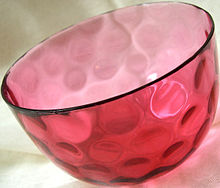- Cranberry glass
-
Cranberry glass (or 'Gold Ruby' glass as it is known in Europe, or 'Rubino Oro' as it is known by glass workers) is a red glass made by adding gold(III) chloride to molten glass. Tin, in the form of stannous chloride, is sometimes added in tiny amounts as a reducing agent. The glass is used primarily in expensive decorations.
Cranberry glass is made in craft production rather than in large quantities, due to the high cost of the gold and the delicate mixing process required. The gold chloride is made by dissolving gold in a solution of nitric acid and hydrochloric acid (aqua regia). The glass is typically hand blown or molded. The finished, hardened glass is a type of colloid, a solid phase (gold) dispersed inside another solid phase (glass).
 The beaker with lid made from Gold Ruby is attributed to Johann Kunckel.
The beaker with lid made from Gold Ruby is attributed to Johann Kunckel.
The origins of cranberry glass making are murky. Some historians believe a form of this glass was first made in the late Roman Empire. The craft was then lost and rediscovered in the 17th century by either Johann Kunckel in Potsdam or by the Florentine glassmaker Antonio Neri in Italy. But neither of them knew the mechanism which yielded the colour. Chemist and winner of the 1925 Nobel Prize in Chemistry Richard Adolf Zsigmondy was able to understand and explain that small colloids of gold were responsible for the red colour.
The most famous period of cranberry glass production was in 19th century Britain during the Victorian Era.
Legend holds that cranberry glass was first discovered when a noble tossed a gold coin into a mixture of molten glass. This legend is almost certainly not true, as the gold must be dissolved in aqua regia before being added to the molten glass.
Cranberry glass creations were most popular as a table display, often holding confectioneries or flowers. Cranberry glass was also frequently used for wine glasses, decanters, and finger bowls. Cranberry glass was also well-known for its use in "Mary Gregory" glass. This glass had a white enamel fired onto the glass in a design, usually of romantic variety.
See also
- Purple of Cassius
References
- http://antiques.about.com/cs/otherglass/a/aa111400.htm
- http://www.laterlife.com/laterlife-family-treasures9.htm
- http://www.glass.co.nz/gibruby.htm
Glass science topics Basics Glass formulation - AgInSbTe
- Bioglass
- Borophosphosilicate glass
- Borosilicate glass
- Ceramic glaze
- Chalcogenide glass
- Cobalt glass
- Cranberry glass
- Crown glass
- Flint glass
- Fluorosilicate glass
- Fused quartz
- GeSbTe
- Gold ruby glass
- Lead glass
- Milk glass
- Phosphosilicate glass
- Photochromic lens glass
- Silicate glass
- Soda-lime glass
- Sodium hexametaphosphate
- Soluble glass
- Tellurite glass
- Ultra low expansion glass
- Uranium glass
- Vitreous enamel
- Wood's glass
- ZBLAN
Glass-ceramics Glass preparation Optics - Achromat
- Dispersion
- Gradient index optics
- Hydrogen darkening
- Optical amplifier
- Optical fiber
- Optical lens design
- Photochromic lens
- Photosensitive glass
- Refraction
- Transparent materials
Surface modification Diverse topics Categories:- Glass art
- Glass trademarks and brands
- Glass compositions
- Glass stubs
Wikimedia Foundation. 2010.

